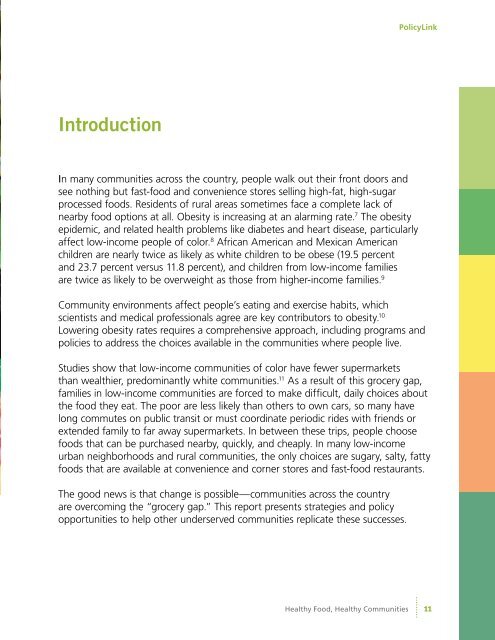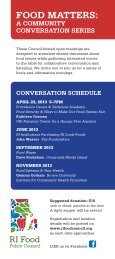Promising Strategies to Improve Access to Fresh, Healthy Food and ...
Promising Strategies to Improve Access to Fresh, Healthy Food and ...
Promising Strategies to Improve Access to Fresh, Healthy Food and ...
You also want an ePaper? Increase the reach of your titles
YUMPU automatically turns print PDFs into web optimized ePapers that Google loves.
PolicyLinkIntroductionIn many communities across the country, people walk out their front doors <strong>and</strong>see nothing but fast-food <strong>and</strong> convenience s<strong>to</strong>res selling high-fat, high-sugarprocessed foods. Residents of rural areas sometimes face a complete lack ofnearby food options at all. Obesity is increasing at an alarming rate. 7 The obesityepidemic, <strong>and</strong> related health problems like diabetes <strong>and</strong> heart disease, particularlyaffect low-income people of color. 8 African American <strong>and</strong> Mexican Americanchildren are nearly twice as likely as white children <strong>to</strong> be obese (19.5 percent<strong>and</strong> 23.7 percent versus 11.8 percent), <strong>and</strong> children from low-income familiesare twice as likely <strong>to</strong> be overweight as those from higher-income families. 9Community environments affect people’s eating <strong>and</strong> exercise habits, whichscientists <strong>and</strong> medical professionals agree are key contribu<strong>to</strong>rs <strong>to</strong> obesity. 10Lowering obesity rates requires a comprehensive approach, including programs <strong>and</strong>policies <strong>to</strong> address the choices available in the communities where people live.Studies show that low-income communities of color have fewer supermarketsthan wealthier, predominantly white communities. 11 As a result of this grocery gap,families in low-income communities are forced <strong>to</strong> make difficult, daily choices aboutthe food they eat. The poor are less likely than others <strong>to</strong> own cars, so many havelong commutes on public transit or must coordinate periodic rides with friends orextended family <strong>to</strong> far away supermarkets. In between these trips, people choosefoods that can be purchased nearby, quickly, <strong>and</strong> cheaply. In many low-incomeurban neighborhoods <strong>and</strong> rural communities, the only choices are sugary, salty, fattyfoods that are available at convenience <strong>and</strong> corner s<strong>to</strong>res <strong>and</strong> fast-food restaurants.The good news is that change is possible—communities across the countryare overcoming the “grocery gap.” This report presents strategies <strong>and</strong> policyopportunities <strong>to</strong> help other underserved communities replicate these successes.<strong>Healthy</strong> <strong>Food</strong>, <strong>Healthy</strong> Communities11



